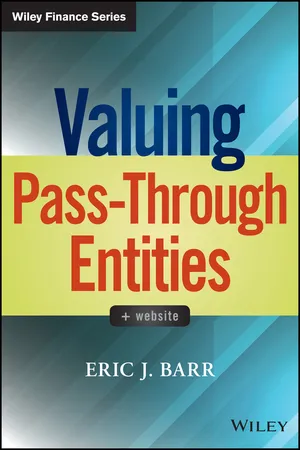
- English
- ePUB (mobile friendly)
- Available on iOS & Android
Valuing Pass-Through Entities
About This Book
The clarity and guidance valuation analysts have been thirsting for
The business appraisal community regularly names the valuation of pass-through entities as a major issue of concern. Courts, appraisers, and the IRS have long been at odds on the topic, and the contention within the appraisal community itself over methods and inputs further complicates the issue. Valuing Pass-Through Entities provides clarity for the analyst tasked with valuation, offering clear explanations of the different perspectives and approaches to the process.
Valuing Pass-Through Entities cuts through the chatter to:
- Explain the advantages and limitations of different types of pass-through entities
- Analyze the different viewpoints currently dividing the appraisal community
- Gain a fresh perspective on landmark cases
- Explain how to properly utilize a court-tested model
- Examine detailed sensitivity analyses of different inputs under the income and market approaches
The book includes illustrative examples, templates, and a useful technical supplement, plus case studies that demonstrate the real-world effects of various pass-through entity valuation methods and inputs. Detailed analyses and an easy-to-apply model simplify the process while positively affecting outcomes. The companion website provides the text of landmark court decisions, a blog featuring industry trends and tidbits, additional articles, and the insight of the author and other industry leaders.
Valuation requires the successful juggling of multiple variables, many of which can have a major impact on value. Analysts need to know how to balance each factor and apply the appropriate rates and discounts, but a lack of standard practice often leaves the issue too subjective. Valuing Pass-Through Entities clears the air, providing real-world guidelines and tools.
Frequently asked questions
Chapter 1
Introduction
Definition of Value
Beauty and Value
Control versus Noncontrolling Interests
Standards of Value
- Transactions (including, but not limited to, leveraged buyouts, employee stock ownership plans, employee compensation plans, and initial public offerings)
- Litigation (matrimonial dissolution, bankruptcy, contractual disputes, owner disputes, and employment and intellectual property disputes)
- Compliance-oriented engagements (financial reporting and tax matters (i.e., corporate reorganizations, S corporation conversions, estate and gift tax compliance, purchase price allocatio...
Table of contents
- Cover
- Series Page
- Title Page
- Copyright
- Dedication
- Foreword
- Preface
- Acknowledgments
- About the Author
- Chapter 1: Introduction
- Chapter 2: The History of Federal Statutory Tax Rates in Maximum Income Brackets and the Evolution of Different Forms of Business Entities
- Chapter 3: Effective Federal Individual and Corporation Income Tax Rates
- Chapter 4: Comparison of Different Entity Forms
- Chapter 5: Income Approach and Value to the Holder
- Chapter 6: Inputs to Modified Delaware MRI Model
- Chapter 7: Income Approach and Investment Value
- Chapter 8: Income Approach and Fair Market Value
- Chapter 9: Fair Market Value Court Decisions
- Chapter 10: The Market Approach
- Chapter 11: Individual State Income Taxes
- Chapter 12: Discounts, Premiums, Bylaws, and State Laws
- Chapter 13: Valuing Complex PTE Ownership Interests
- Appendix A: Checklist
- Appendix B: Case Study: Bob's Cruises
- About the Website
- Index
- End User License Agreement